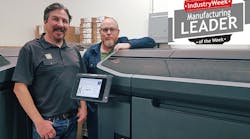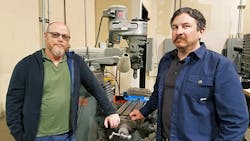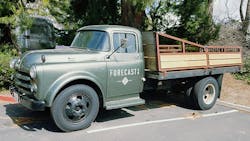CARLSBAD, California — Manufacturing is often rewarding and productive and honest, but it is not often fun. Run an efficient line, establish some best practices, and the whole thing doesn’t really need to be fun. It certainly can be fun, though.
Corey Weber and Donovan Weber make it fun.
The brothers founded Forecast 3D almost a quarter of a century ago, setting up shop thanks to an $8,000 loan from their grandfather, an old Detroit machinist who packed up his family back in 1962 and only parked the car for good after he reached the Pacific. His name was Mark Weber. He went by Bud. Long after Corey and Donovan repaid his loan, his fingerprints and influence remain obvious.
Like most young shops, Forecast 3D started small, adding new machines whenever profits allowed and orders demanded. Today, their crew of about 100 employees churns out parts through every sort of additive and subtractive manufacturing process (ProCAST RTV, stereolithography, selective laser sintering, PolyJET, CNC, and HP’s new Multi Jet Fusion chief among them) for all sorts of customers (nearly three-quarters of their orders are for major aerospace, automotive and medical companies.). Their annual revenue is right around $14 million and climbing. They smile and laugh all the time.
“It’s kind of hard not to have fun,” said Donovan, who could be a voice double for Nick Offerman, most famous for his portrayal of disgruntled federal employee Ron Swanson on Parks and Recreation. “We get to see 60, 70 new projects a day, and we’ll start at least half of those. It’s kind of not fair, right? It’s so exciting, you walk in every day and it’s something new. It’s inherently fun to be in product development.”
“It’s not boring,” said Corey, who bears a passing resemblance to a young Black Francis, front man of the rock band The Pixies. “I get a little too serious about it sometimes, and I need to lighten it up a little. Donovan is good at keeping it light.”
“Try to,” Donovan said.
They keep it light with a robot painting that stretches 15 feet across the back wall of the lobby, with a fleet unlike most plants parked out back (a 1956 Dodge military flatbed used for delivering heavier models and a 1968 Airstream trailer used for … road trips?), with a culture that keeps more folks than not around for a dozen years or more.
They keep it light with the work, too.
Forecast 3D almost always has its eye on the latest tech, including the aforementioned HP Multi Jet Fusion. They’ve had two machines on their floor for a little more than a month — a benefit of being a foundational partner with the Palo Alto leader on its newest next big thing — ever adapting, never dying. We’ll start our conversation with the Webers focused, like they are, on that tech.
IndustryWeek: You two are major champions for HP and its Multi Jet Fusion additive manufacturing printers. Simple question, and probably complex answer: Why?
Donovan Weber: We used to have eight SLS machines. We had a full aerospace production facility, doing aerospace and drone work a lot. Our expectations of this technology juxtaposed with SLS technology … you walk into an SLS lab and they don’t have this. That’s just a machine, you pull it out, you slide it over. Nobody had really baked out the post-processing like HP did. It’s messy, the lab’s coated with a fine layer of dust, but the beauty of the self-containment — of the filter, of the light, of the interface — from a processing standpoint, it’s a game-changer.
Corey Weber: We already had machines that could print pretty nice nylon parts, but you couldn’t print them fast enough and cheap enough for end users. For prototypes, it was fine, but when you were trying to go after production runs, no way. To be able to make 2,000 quality parts in a day. That’s what’s new.
DW: The other thing that made me think about this technology differently is you could load up one part, and say the whole thing would take 10 hours. You could jam pack that entire machine with every bit of usable space, with as much density as you could — in 10 hours. Same time. The scale of economy in a single build allows us to be more aggressive with cost for our customers.
CW: If you’re going to make an injection mold and you don’t have a budget for three different injection molds — because this product goes on three unique other products that need to be adapted, you’d have to buy three tools — with additive on demand, you don’t have to. What we’ve seen until now, the vast number of designs we’re seeing are not optimized for additive. They’re designed primarily for injection molding, and they’re leaving a lot on the table, because those parts can’t be nested.
Matt LaWell, IndustryWeek / Forecast 3D CEO Corey Weber and COO Donovan Weber stand in front of the old Bridgeport used by their machinist grandfather — whose name was Mark, and who went by Bud.
IW: You have about 30 machines on your floor now, with no more than a handful of any one kind. But you say you plan to load up MJF printers. At face value, that sounds like a gamble.
CW: We like having a lot of services, because certain products really require a specific service. They won’t call out for multiple options. We want to give our clients right process or the right parts for the job. … Our main goal as far as MJF goes is to provide benchmarks to companies and to supply companies with MJF parts before they’re willing to buy a machine of their own or smaller companies that don’t have enough volume to fill up an entire machine. We’ll probably do some kind of lease program, too. We’ll be doing some interesting production-based programs.
It’s all about getting additive more into production, and that’s the real exciting thing that’s going on right now.
IW: You two seem to have built up Forecast pretty consistently, nice upward trajectory, from the two of you in 1994 to about 100 people now. What have been some of the challenges that remain after 23 years as a rapid prototype and custom short-run producer?
CW: I guess one of the biggest challenges we face is the cyclical sales nature of prototyping. … We go into it and look at your specifics: How quick do you want it? And what material do you want? What are you trying to accomplish? Is this a protagonist? Short-run production? What are your materials plans? We can come in with a really holistic approach.
DW: You can fill this shop up in days, because it’s such a high volume and such a quick turn.
CW: One of the challenges is getting the word out about additive. The majority of the designs we get, probably 96% or 97%, are not really designed for additive. There’s so much room for improvement. Everybody has been designing parts with the same rules for so long now that I think that is one of the challenges, getting people to think in different ways: this part doesn’t need to have drafts, you don’t have to worry about these undercuts, think about nesting. There’s so much to be gained by designing with additive in mind.
IW: Have more companies started to come to you with that mindset?
CW: No. Not really. I see files here and there.
DW: It’s a lot of posturing. They know additive is so much cost per part —
CW: Well, a lot of them believe that additive is this much cost per part, and they don’t know it can be less.
IW: What have been some of the challenges that, historically, you’ve managed to solve?
DW: The additive piece is so funny, right? When we first started, it was rapid prototyping and our sales calls were exploratory, educational. Engineers had no idea in 1994, and it was the first eight, 10 years before people were, like, “Oh, yes, absolutely.”
CW: We should have started calling it 3-D printing from the beginning. … But this was all rapid prototyping and there wasn’t a whole lot of change going on from the late ’90s into the 2000s.
DW: The general acceptance of additive, more than just being prototypes, it was generally accepted to get into short production runs if the materials could be qualified, if the process could be qualified, and if it made financial sense. We’re no longer in a mode where we’re constantly teaching our customers. There’s a general knowledge and acceptance now. 90% of the people we talk with are mechanical engineers.
Matt LaWell, IndustryWeek / Forecast 3D actually uses this 1956 Dodge military flatbed to make some deliveries for larger parts around San Diego. The 1968 Airbus in the background is used for more recreational trips.
IW: Neither of you had much connection to manufacturing before you opened your doors in 1994. (Corey only stumbled into it after working in construction and as a carpenter for a stretch during the late 1980s and early ’90s and answering an ad for a model maker. Donovan studied machine tool tech and business at a local community college.)
DW: So I graduated high school, went to the local community college, InterCoast, took two rounds of machine tool technology — they had a pretty sweet little setup with a decent amount of equipment and some great, great instructors on mills and lathes, just the basics — and I was taking business classes, so somehow that worked. … I went to school for a year and a half, then we started this business. We were kids.
CW: I was good at understanding things. … A lot of the equipment and processes we use are all designed and built in-house. We don’t go outside for too many things other than the equipment. If I were to do it all over again, I would definitely be getting an engineering degree.
DW: Go to school, kids!
IW: Do many of your employees fall under that same umbrella — smart people who maybe just sort of bumped into the industry?
DW: Most of the people who are qualifying have fine motor skills, have the eye for squareness the ability to really get into a part —
CW: And to be able to execute, because the majority of our labor is finishing castings, finishing models, so you can’t be all thumbs, and eight out of 10 people probably are. You can tell as soon as they pick up a tool.






